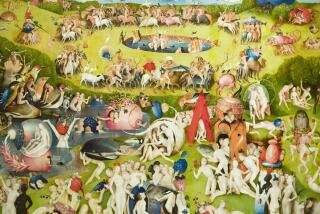American Gothic
- Share via
The romance of ruin lies thick upon the pages of Andrea Barrett’s “Servants of the Map.” Fossils, scripture, letters, memories, the dead and the dying open doors to the past with a startling, informed ease and a poignancy that is matched only by the travails of the men and women left behind who must ponder the meaning of change and evanescence of their own lives, lived in the shadow of eternity, memento mori.
“Servants” is a collection of short stories and novellas in which Barrett mines, as she did in “Ship Fever” and “The Voyage of the Narwhal,” nothing less than the vastness of the 19th and 20th centuries to cast a light on the collision that occurred when the empirical facts of life on the planet suddenly outpaced any ability to explain or even to know them. Where God and faith once provided the epistemology, there now existed a void into which science threw itself in a noble attempt to recover what had been lost.
Taking us from the Age of Reason to the Age of Uncertainty, Barrett channels the zeitgeists as deftly as British novelists A.S. Byatt and John Fowles, but her sensibility is American. Her characters are a beguiling blend of loneliness, resilience and tragic resignation. Like children expelled from the garden, they wander the wilderness, trusting that the answers and the knowledge they once had is attainable again.
Max Vigne wanders the farthest. When we meet Vigne--in the first story of the collection--the year is 1863, and he is one of the many surveyors--Servants of the Map, as they are called--attached to the Grand Trigonometrical Survey of India. He is writing a letter to his new wife, Clara, back in England, trying to convey the majesty of the world he is struggling to measure: “Try to imagine,” he scribbles enthusiastically, “the whole chain of the Himalaya, as wide as England and four times its length.”
Ultimately, though, the altruism of the project fades, and what emerges in Max is the romantic--if not existential--self picking its way through the hardship of the world, struggling to know the meaning of its life. “Who am I? Who am I meant to be? I imagine a different life for myself, but how can I know, how can anyone know, if this is a foolish dream, or a sensible goal?”
This unknowing consumes Barrett’s characters. Whether it is Vigne triangulating the subcontinent or Samuel Bernhard, in a later story, searching for evidence of life before the Flood in the sandstone cliffs of the Ohio Valley, Barrett’s heroes are marked by an obsessive certainty that the truth belongs to the most tenacious.
It is a course that makes them not a little desperate as they watch their tenets of faith slowly melt away in a losing struggle to adequately understand the world. Science tries its hand, but it too fails. In “The Mysteries of Ubiquitin,” a young woman, a molecular biologist, mourns the death of her mother, clipped as she walked along a lakeshore road by a speeding motorist. “A hundred times, a thousand times, Rose would try in the following years to reconstruct her mother’s life and mind, her mother’s death. What was science for,” she wonders, “if not for this?”
But Barrett knows that such inquiry is useful in fiction only if it mirrors a deeper psychology. Her characters--Lavinia in “Theories of Rain” in 1810, pining for her lost brother, lost when their parents died and the village found new families to care for them; Miriam in “Two Rivers” in 1853, remembering the life of her dead husband, who also became a paleontologist in Ohio; or Bianca in “The Forest” in 1979, searching for an identity beyond her family--relive the torments of the past through the courses they follow in the present.
Science as metaphor, however, is a balancing act, and at times the pleasures of “Servants” are more of the mind than of the heart, leaving one to wish for a more sustained narrative. By revisiting characters from previous work in “Servants of the Map”--Barrett brings back, as little girls and adults, the Mapson sisters from “Ship Fever”; a younger Lavinia, who went on to become the botanist aboard the Narwhal; and Nora Kynd, the child separated from her family in “Ship Fever”--she leaves us to create our own family trees, all the more tangled for the fragmented connections among these stories. Were she to have compiled these threads, as brilliant as they are, into a longer narrative, we might have had an even more affecting book than this collection.
In the final story, “The Cure,” Vigne reappears in absentia. It’s nearly 40 years later, and his daughter manages an inn in the Adirondacks for consumptives. Vigne, as we learn, never able to reconcile ambition with family responsibilities, continued his wanderings from Kashmir to Venezuela, Japan to Borneo, and his family reconciled themselves to his absence and their own lives without him.
Time and space course through these stories like a river slowly eroding its banks and altering the land upon which we stand. As Barrett’s men and women struggle to reconcile the capriciousness of fate and the elucidating promise of science, they edge closer to a deeper awareness of their own mortality, and Barrett is wise enough to know that such journey is not just moving from one place to another but living toward the final destination.
More to Read
Sign up for our Book Club newsletter
Get the latest news, events and more from the Los Angeles Times Book Club, and help us get L.A. reading and talking.
You may occasionally receive promotional content from the Los Angeles Times.











